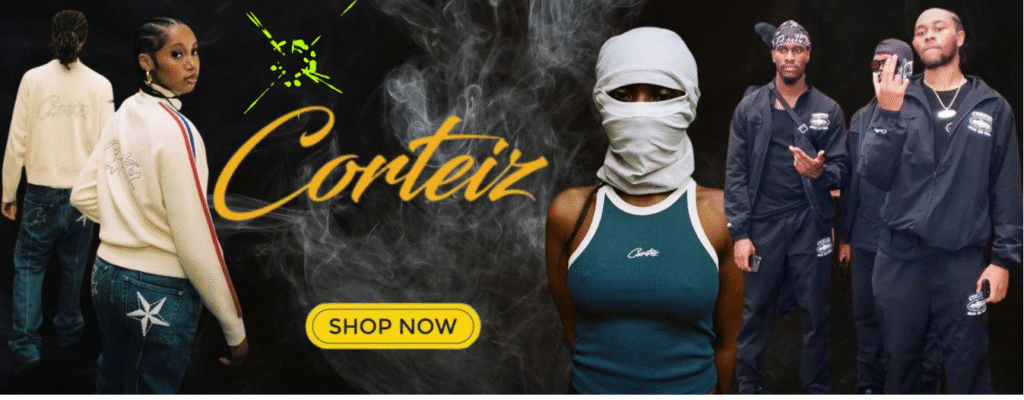
Fashion has always been more than fabric. What people wear reflects values, beliefs, and identity. A simple hoodie or cap can carry the weight of an entire movement if the brand behind it speaks to something deeper than style.
Today’s youth no longer see fashion as just seasonal trends. They want something that connects to who they are and where they belong. A powerful brand creates more than clothes; it builds an invisible bond between wearers. It gives them a sense of membership that feels more cultural than commercial.
This is why Corteiz stands out. It doesn’t only release collections, it creates moments. Every launch feels like a call to those who understand the deeper message. In this way, the label is moving beyond retail into territory where clothing becomes symbolic, almost tribal.
How Does Streetwear Connect With Community Values?
Streetwear, by nature, is tied to the streets, and the streets have always belonged to the people. Unlike luxury fashion houses that dictate trends from glossy runways, streetwear is driven by community voices, grassroots creativity, and cultural storytelling.
Young people wear it not only for style but also to express identity and solidarity. Streetwear carries echoes of skateboarding, hip-hop, and underground rebellion. These movements all flourished because of tight-knit communities that valued authenticity over polish.
Corteiz thrives in this landscape. Instead of chasing mainstream attention, it builds its influence by connecting to shared values, resistance, pride, and loyalty. Its presence feels less like advertising and more like conversation. In doing so, it gives wearers something rare: the feeling that they are part of something bigger than themselves.
Why Do Youth Gravitate Toward Hidden Access?
Scarcity has become one of the strongest currencies in modern fashion. People no longer want what is everywhere; they want what is hidden, hard to find, and limited in number. This makes clothing feel less like a product and more like a trophy.
Young fans chase the thrill of discovery. Password-protected drops, secret codes, and limited runs create excitement that mass production can never deliver. To own a rare piece is to prove you made it past the gates others couldn’t enter.
Corteiz uses this strategy effectively. Each drop feels like a mission, where only those with dedication or insider knowledge succeed. This selective access builds more than hype; it builds loyalty. When someone wears a rare piece, they are signalling that they belong to an inner circle, a hidden tribe that not everyone can join.
Could Clothing Be the New Digital Passport?
Social media has transformed fashion into more than just physical style. What you wear is no longer seen only on the streets; it is broadcast instantly to online audiences. Outfits act like visual passports, signaling culture, taste, and belonging.
A hoodie or jacket, once photographed, becomes a digital badge. It tells the world, “This is my tribe, my style, my belief.” Clothing is no longer private; it’s a public identity that crosses borders instantly.
This is why Corteiz resonates strongly online. Every photo, hashtag, and repost strengthens the invisible threads connecting its wearers. You don’t need to meet in person to feel the bond. The digital passport offered by this brand makes membership recognisable on a global scale. Whether in London, New York, or Tokyo, the tribe can spot its members through what they wear and share.
How Does Rebellion Shape the Digital Tribe?
No tribe survives without a unifying force, and for street culture, that force has always been rebellion. It is the refusal to blend into the system, the desire to stand apart, and the courage to reject rules imposed from above.
Fashion has long been used as a tool of resistance. Think of ripped jeans in the punk era or oversized fits in hip-hop; these weren’t just styles, they were statements of independence. Youth use clothing as their voice when systems silence them.
Felpa Corteiz embraces rebellion at its core. Its campaigns often feel raw and unapologetic, with messages that push back against conformity. Wearing the brand becomes more than wearing fabric; it becomes a personal act of defiance. That shared spirit of resistance strengthens the digital tribe, turning wearers into not just customers but comrades.
What Role Does Storytelling Play in This Movement?
Clothing without a story is just material. But when attached to narrative, it transforms into memory, identity, and even heritage. Brands that master storytelling create bonds that outlast seasonal trends.
Corteiz thrives on this. Each drop is wrapped in mystery, cryptic messages, unexpected campaigns, and visuals that spark curiosity. Fans debate meanings, share interpretations, and build their own myths around the brand. The storytelling doesn’t dictate; it invites participation.
This shared narrative becomes a glue that binds the tribe. Wearers don’t just buy clothes; they help write the story. Every post, every street shot, every online comment adds another layer. This co-creation makes the tribe stronger, because people feel they aren’t outsiders watching but insiders shaping the movement.
Is This the Blueprint for the Future of Fashion?
Fashion is shifting. The old model of mass production and seasonal cycles no longer holds the same weight. Today’s culture values belonging over abundance, identity over trend, and storytelling over sales pitches.
Digital tribes are emerging everywhere. Instead of simply selling to customers, brands are building loyal followings who defend, promote, and spread the message as if it were their own. This community-first approach could redefine the entire industry in the coming decade.
Corteiz may be at the front of this shift. Its mix of scarcity, rebellion, and digital connection sets the tone for how future fashion tribes might form. It shows that success doesn’t come from being everywhere it comes from being meaningful to the right people. If the movement continues, we may be witnessing the blueprint of a future where clothing is not only style, but also identity, culture, and belonging.




